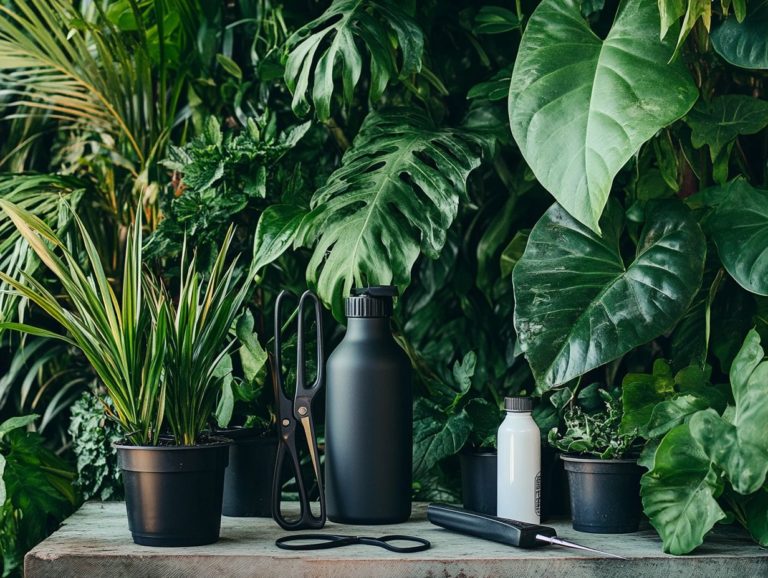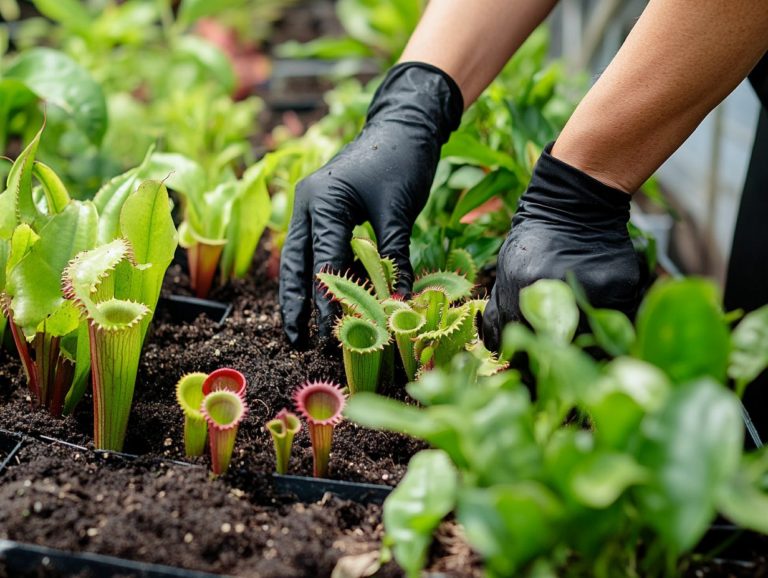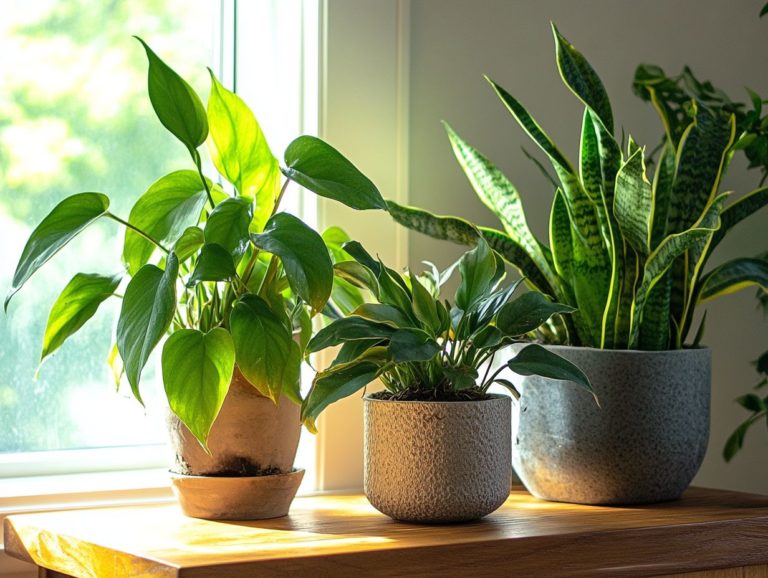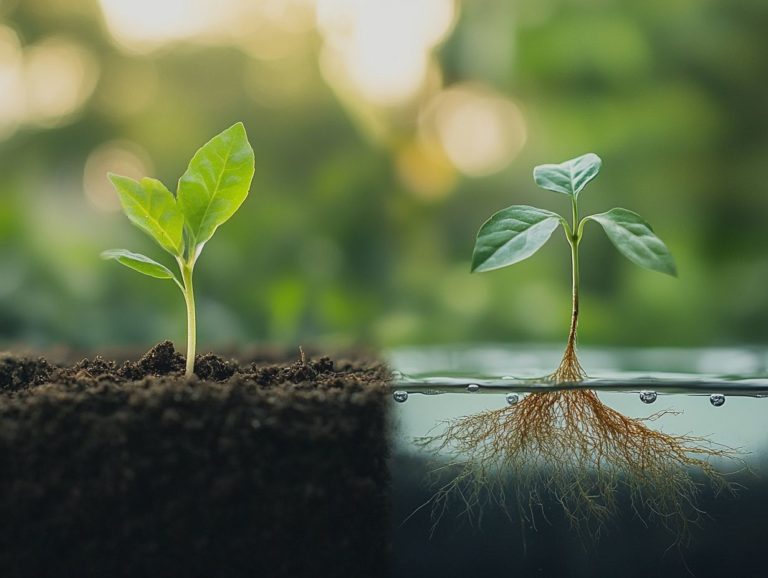Tips for Propagating in Water
Propagation in water is an exhilarating and approachable method for growing new plants from cuttings. You can observe the roots developing right before your eyes!
This technique has many advantages over traditional soil propagation. You’ll love how delightful it is for any plant enthusiast.
In this guide, you will discover the essential supplies needed, a step-by-step process for success, and helpful troubleshooting tips for common challenges along the way.
You will also find creative ways to display your beautiful water-propagated plants. Immerse yourself in this captivating journey and unlock the secrets to cultivating thriving greenery!
Contents
- Key Takeaways:
- Benefits of Propagating in Water
- Supplies Needed for Propagating in Water
- Step-by-Step Guide to Propagating in Water
- Troubleshooting Common Issues
- Creative Ways to Display Water Propagated Plants
- Frequently Asked Questions
- How do I know when my plant is ready to be transferred to soil after successful propagation?
- What should I do if my plant is not rooting in water?
- Can I use tap water for propagating in water?
Key Takeaways:

- Easy and Cost-effective – Propagating in water is a simple and affordable way to grow new plants.
- Requires Basic Supplies – You only need a few essential tools and materials to successfully propagate in water.
- Endless Possibilities – There are many creative ways to display water-propagated plants, making it a fun and versatile method of plant propagation.
What is Propagation in Water?
Propagation in water is a captivating method for growing new plants from cuttings immersed in water. This allows them to develop strong roots.
This technique has become a favorite among plant lovers who want to effortlessly expand their indoor collections using cuttings from established plants like Pothos, Monstera, and Hoyas.
By providing optimal conditions think bright, indirect light and fresh water your cuttings can thrive. They will produce robust roots that can eventually be transferred to soil for healthy growth.
Water propagation offers a simple and visually appealing way to multiply your green companions. You can witness the fascinating process of root development up close!
Many indoor plant lovers prefer this method because it removes the uncertainties tied to soil propagation. You get a clear view of your cuttings’ growth stages.
Plants like Spider plants and Snake plants are popular choices for this technique. Their resilience and quick rooting abilities make them ideal for beginners.
As more people embrace the joy of nurturing plants this way, water propagation continues to gain popularity, transforming living spaces into lush, green sanctuaries.
Benefits of Propagating in Water
Propagating plants in water offers numerous benefits that enhance the overall health and vitality of your indoor greenery. It s a highly regarded method among plant enthusiasts.
This technique lets you see the detailed process of roots forming firsthand, ensuring that new roots flourish in a healthy manner.
The water medium delivers essential nutrients for rapid root growth. This helps your plant cuttings thrive and remain vibrant as you monitor their progress.
Advantages over Other Methods
Water propagation has distinct advantages over soil methods, making it an enticing option for indoor plant enthusiasts like you. This technique provides a clear view of root development, giving you immediate feedback on whether your cuttings are thriving or struggling.
Unlike soil propagation, which can hide the roots, water propagation encourages healthy roots to flourish. This often results in quicker root establishment.
You can use propagation jars and even rooting hormones to boost growth. The beauty of water propagation lies in its simplicity; it requires minimal materials just a suitable container and fresh water!
Many enthusiasts appreciate the aesthetic appeal of cuttings displayed in clear vases. This transforms their propagation efforts into decorative focal points within their homes.
This method also reduces the risk of overwatering, a common challenge with soil propagation. You can easily monitor and adjust the water level.
With the ease of replacing the water, you can ensure that your cuttings remain in an optimal environment for development. It’s an ideal choice for novice gardeners and seasoned plant lovers alike.
Start your propagation journey today and fill your home with lush greenery!
Supplies Needed for Propagating in Water
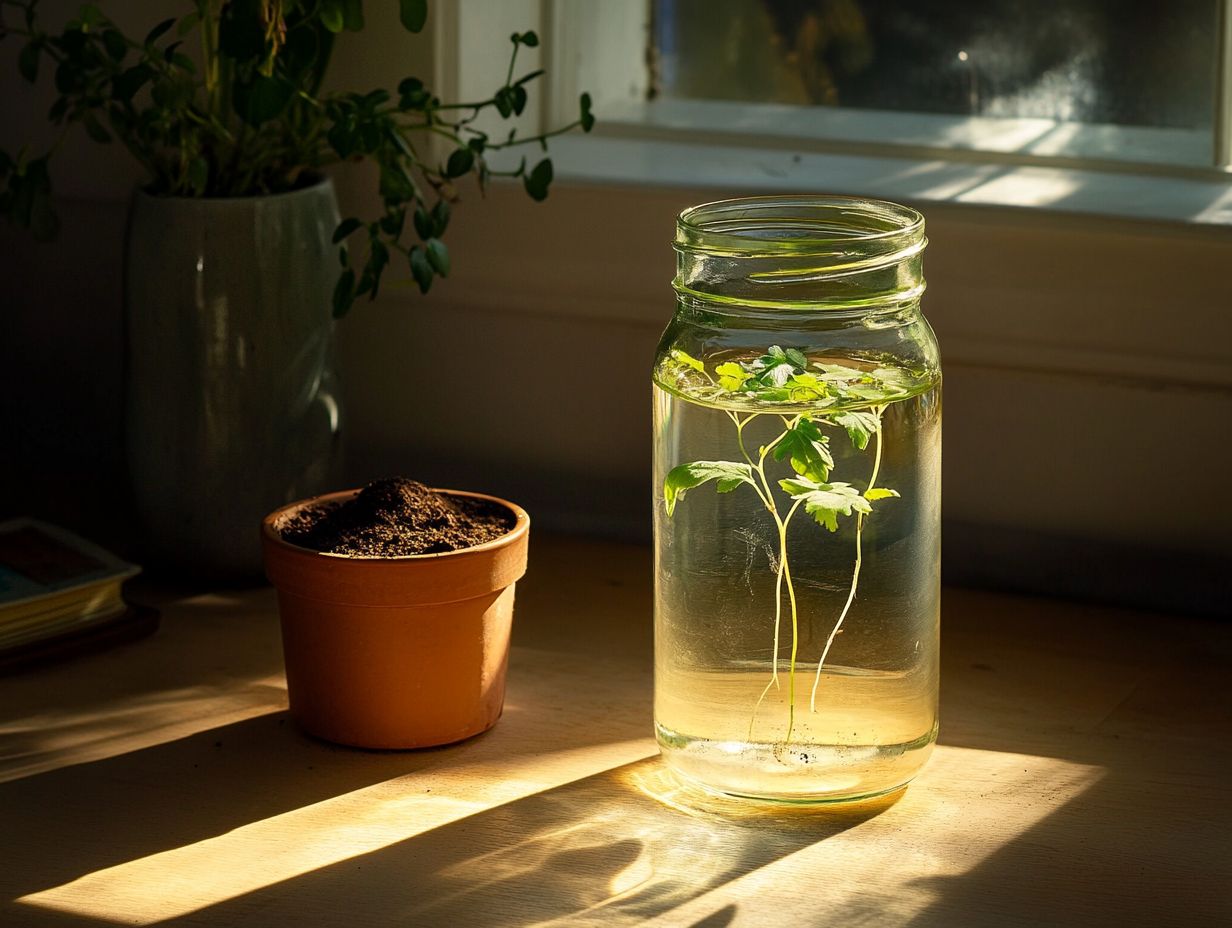
To successfully propagate plants in water, you ll require specific supplies that help plants grow roots efficiently. Key tools include:
- a glass vessel or propagation jar
- sharp, clean snips for taking cuttings
- and perhaps a rooting hormone like Clonex to expedite root growth.
These essentials create the ideal environment for your cuttings to flourish, allowing them to absorb necessary nutrients effectively as they develop a robust root system.
Essential Tools and Materials
The essential tools and materials for effective water propagation include a range of items that ensure your plant cuttings have everything they need to thrive. You ll want to gather a glass vessel or a propagation vase, along with sharp, clean snips for taking cuttings and maintaining hygiene.
Fresh water is a must, as it provides the necessary nutrients for strong root development. A clear container is helpful, as it allows you to easily monitor root growth and water clarity. An accurate ruler or measuring device will help you ensure each cutting is the proper length, which is essential for successful rooting.
A natural light source is equally important, encouraging vigorous growth while preventing your cuttings from becoming leggy. You can place a few pebbles or stones at the bottom of the vessel to stabilize the cuttings and keep them submerged at the right level in the water.
Each of these tools plays a significant role in promoting healthy root development and overall plant vitality.
Step-by-Step Guide to Propagating in Water
Follow this fun step-by-step guide to propagate your favorite indoor plants easily!
- You ll start by selecting healthy plant cuttings, making a precise cut just below the node (the part of the stem where leaves or roots grow), and trimming away any excess leaves.
- Next, place your cuttings in a clear glass vessel filled with fresh water, ensuring they bask in bright, indirect light while you maintain the water level.
- Don’t forget to change the water weekly; this simple act provides the fresh nutrients essential for healthy root growth.
Instructions for Successful Propagation
Following specific instructions for successful propagation is essential to ensure your cuttings develop robust root clusters. Begin by using sharp, clean snips to take cuttings from healthy parent plants, cutting just below a node. Place the cuttings in a glass vessel filled with fresh water, and keep an eye on the water level, changing it weekly to prevent stagnation and encourage new root growth.
Providing adequate lighting is crucial; indirect sunlight promotes healthy development without risking damage to those delicate leaves. Be mindful of temperature fluctuations, as maintaining a steady, warm environment can further support root establishment.
Observing your cuttings for any signs of rot or disease is key if you notice any discoloration or mushy textures, remove the affected cutting immediately. Remember, patience is vital during this phase, as roots may take several weeks to form.
Keeping a dedicated journal will help you track progress and highlight successful strategies for your future propagation efforts.
Troubleshooting Common Issues

Troubleshooting common issues during water propagation is essential to keep your plant cuttings thriving! As a dedicated plant parent, you may face challenges like slow growth or unhealthy roots, often stemming from factors such as inadequate light, water quality, or nutrient imbalances.
By identifying these issues early, you can take proactive steps to correct them, fostering healthier root development and enhancing your chances of successful propagation.
Tips for Overcoming Obstacles
Implementing effective strategies to overcome obstacles can significantly elevate your success in propagating plants in water. Ensure that your cuttings are placed in bright, indirect light; insufficient lighting can impede growth and vitality. Changing the water weekly is essential for maintaining freshness and providing the necessary nutrients, allowing your plants to thrive.
It’s equally important for you to regularly monitor the temperature and humidity levels in your environment, as these factors greatly influence root development. If the surroundings are too cold or too dry, your cuttings may experience unnecessary stress.
Opt for a clear container to easily track root growth. Consider adding a drop of liquid fertilizer for that extra boost. Don’t forget to promptly remove any old or yellowing leaves; this encourages healthy growth and helps prevent bacterial buildup that could jeopardize the health of your water propagation system.
Following these strategies will make your plant propagation journey more fruitful and efficient.
Creative Ways to Display Water Propagated Plants
Displaying water-propagated plants in a creative manner can elevate the aesthetics of your indoor space while beautifully showcasing the intricate growth of roots. By incorporating stylish propagation jars or distinctive glass vessels, you have the opportunity to craft stunning visual statements that draw attention to the vibrant roots and lush foliage of plants such as Pothos, Monstera, or Hoyas.
These displays also serve an important decorative purpose and reflect the joy of taking care of plants.
Innovative Ideas for Showcasing Plants
Innovative ideas for showcasing water-propagated plants can elevate your indoor houseplants into captivating focal points in your home.
Picture this: elegant glass terrariums that allow the roots to be admired from every angle, or a striking vertical garden that makes the most of your limited wall space. Get creative! Use old bottles or driftwood to add rustic charm to your displays.
Incorporating roots grow techniques with water roots can lead to fast root growth. Wrap fairy lights around your displays to create an enchanting ambiance instantly!
Mixing various sizes and shapes of containers will add depth and intrigue, ensuring that these beautiful plants truly stand out.
Frequently Asked Questions

What are some tips for propagating plants in water using the best propagation method?
1. Use clean, filtered or distilled water: This ensures that the plant is receiving pure water without any contaminants that may harm its growth. Remember to feed as soon as you see new roots.
2. Choose the right container: Use a clear glass or plastic container, such as a propagation vase, to allow sunlight to reach the roots and promote growth.
3. Cut the stem at a 45-degree angle: This will increase the surface area for absorption and allow the roots to grow more easily. Make sure to cut below the node for optimal results.
4. Change the water regularly: Fresh water promotes healthy root growth and prevents the build-up of bacteria. When the water level drops, it’s time for a refill.
5. Use rooting hormone: This can help speed up the propagation process and improve the success rate. Clonex rooting is a popular choice for many plant enthusiasts.
6. Remove any leaves below the water line: This prevents rotting and promotes the growth of new roots. Always remove leaves to keep the water clean.
How long does it take for a plant to root in water?
The time it takes for a plant to root in water varies depending on the type of plant and its growing conditions. With ideal conditions, you might see root clusters developing sooner.
Can any plant be propagated in water?
Most plants can be propagated in water, but some are more successful than others. Plants with soft stems, such as Pothos cuttings or philodendrons, tend to root more easily in water compared to plants with woody stems like Tomatoes and Basil.
Start your water propagation journey now and watch your plants thrive!
How do I know when my plant is ready to be transferred to soil after successful propagation?
Your plant is ready for soil when it has a strong root system. Look for a good number of healthy roots at the bottom of the stem.
What should I do if my plant is not rooting in water?
If your plant isn’t rooting, change the water frequently. You can also use rooting aids or give your plant more sunlight.
Another effective method is to propagate from a wet stick. This can lead to better results!
Can I use tap water for propagating in water?
Tap water might contain chemicals that can harm your plant and slow root growth. Using clean, filtered, or distilled water is the best way to help your plants thrive!

